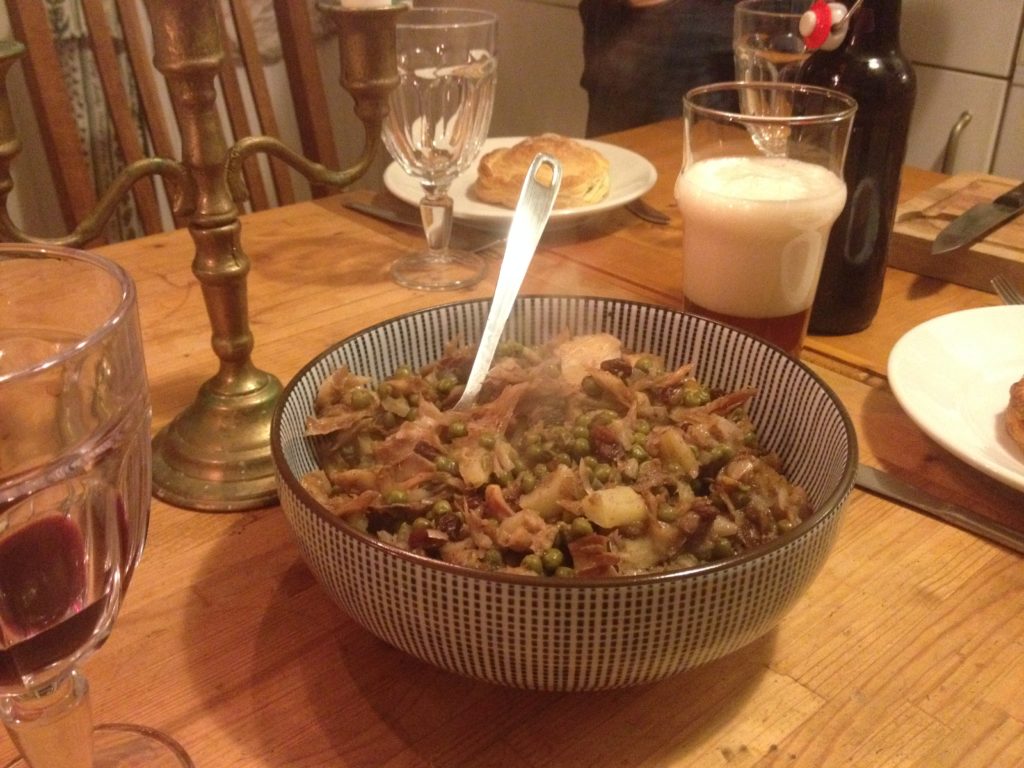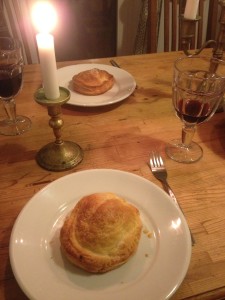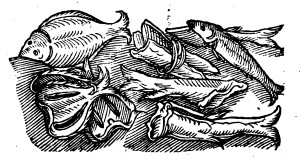Medieval Stockfish recipe: Stockfish with peas, apple, and raisins
Bart Holterman, 14 July 2016
On the 11th of June 2016, a “Gastronomic stockfish symposium” took place in the city of Bergen, Norway, during the International Hanseatic Days 2016. The symposium highlighted the important role of dried fish for the history of the city. After all, without the high demand for stockfish in pre-modern Europe the city would probably never have become the medieval and early modern trading hub for northern Europe. Until c. 1500 stockfish coming from northern Norway and Iceland was brought to Bergen, and from there traded with merchants from the European mainland and the British islands, in exchange for grain and other commodities. This led to the establishment of the Hanseatic Kontor, the remains of which still exist as the Tyskebrygge quarter in the city, dominated by merchants from Lübeck, who had a near monopoly on the stockfish trade for centuries.
Topics during the symposium were very diverse, illustrating the multi-faceted influence of stockfish on the economy and culinary culture of Norway and the rest of Europe, in the past and today. The papers presented ranged from the influence of climate change on cod stocks to the culinary stockfish traditions on the Iberian peninsula, in Upper Franconia, and in Northern Italy. In the latter case, there even exists a stockfish brotherhood which seeks to preserve the culinary stockfish tradition in Italy. All presentations (with pdf files and videos) can be found here. I presented the stockfish consumption in medieval Germany, combining Hans Christian Küchelmann’s archaeozoological research and my own, based on written sources such as cook books.
This provides the perfect opportunity to present another medieval stockfish recipe which we tested a while ago: stockfish with peas, apple and raisins. As the name suggests, the recipe is an example of the same typical medieval combination of hearty and sweet tastes which was also prevalent in the previous recipe of Spanish puff pastry, and which might seem peculiar to modern taste. It is derived from a fifteenth-century manuscript from Flanders which is being edited by Christianne Muusers on her wonderful website Coquinaria. She interpreted the recipe as a typical winter recipe, since all ingredients were available in dried form at the time. We took fresh or deep-frozen ingredients (except for the stockfish), which tasted just as well. For Muuser’s transcription and interpretation of the recipe, see this page.
Cooking time: ca. 1 hour (+ 1,5 day preparation)
Ingredients (2-3 persons):
- 100g stockfish (makes about 200g fish meat when soaked an cleaned)
- 200g peas
- butter
- 1 apple, in pieces
- 1 large onion, sliced
- 100g raisins
- pepper
- cardamom
- mixture of cinnamon, cloves, and mace (or nutmeg)
- ginger powder
Preparation:
- Hammer the stockfish well for a while (if needed: some stockfish is sold pre-hammered). Soak the fish in water for 1-2 days, refresh the water a couple of times a day. When the fish is well soaked, remove the skin and bones. Take care to remove all the small bones!
- Fry the onion until golden. Add the apple and stockfish pieces and let it fry for a while, then sprinkle the spices over it.
- Add the peas and some water, stir and let it simmer with a closed lid on low fire, 20-30 minutes.
- Add the raisins during the last 10 minutes.
- Serve hot.
Historical stockfish recipe: Marx Rumpolt’s “Spanische Krapfen” (tested!)
Bart Holterman, 29 February 2016
In the later middle ages, stockfish was one of the most valued goods of the North, and one of the most important reasons for German merchants to trade with the islands in the North Atlantic. Stockfish is dried cod or another species of fish from the gadidae family. After drying, which can only take place in polar regions, the fish becomes hard as a stick, hence the name (from German/Dutch “stock”: stick).

A man hammering stockfish, detail from Pieter Bruegel the Elder’s Thin Kitchen (1596). Photo: Rijksmuseum Amsterdam.
In this dried form, the fish can be preserved for many years, an important feature in a time when canned food, refrigerators or freezers were not invented yet. Therefore the stockfish was in high demand, although its preparation was very time- and labour-consuming. First of all, the dried stockfish needed to be hammered for a while to soften the flesh, and subsequently soaked in water for one or two days. Moreover, the taste was not considered to be very special to some. Marx Rumpolt, the cook of the prince elector of Mainz, remarked that “although many dishes can be made with it, it is just a stockfish, and it remains a stockfish […] and it is not worth the effort”.
Nevertheless, Rumpolt listed twelve recipes for stockfish in his 1581 cookbook, Ein new kochbuch. We decided to try one out and share the results here: Spanische Krapfen (Spanish puff pastry). It is a sweet pastry filled with stockfish sauce and raisins. The combination of sweet and hearty was quite common for upper-class cuisine of the late medieval and early modern time, but to modern taste it might seem a bit peculiar. Opinions within the team were divided: some rather liked the result, others found it too strange to really enjoy the meal. However, the fishy taste is almost absent, and it is certainly worth a try.
Note: pre-modern recipes do not contain precise indications for amounts, temperatures, or cooking times. Moreover, in Rumpolt’s time pre-made puff pastry was not available, so he had to make it himself. As the cook of our team, I was too lazy to do that. The following is therefore my own interpretation of Rumpolt’s recipe. For the more adventurous (or historically correct) cooks, the original recipe can be found here (page CXXXIII, recipe 5-6).
Cooking time: ca. 1 hour (+ 1,5 day preparation)
Ingredients (4 persons):
- 150 g stockfish (makes about 250 g fish meat when soaked and cleaned)
- puff pastry
- 30 g butter
- 30 g wheat flour
- 250 ml milk
- (cane) sugar
- a pinch of salt
- 50 g raisins
Preparation:
- Hammer the stockfish well for a while (if needed: some stockfish is sold pre-hammered). Soak the fish in water for 1-2 days, refresh the water a couple of times a day. When the fish is well soaked, remove the skin and bones. Take care to remove all the small bones!
- Pre-heat the oven at 180°C. When using deep frozen puff pastry, take it out of the freezer and let it defreeze.
- Cook the fish well for 20 minutes, until it starts falling apart. Let it drip out in a sieve, press out as much water as possible. Cut the fish into tiny pieces.
- Make a roux by melting the butter in a pan. Add the flour. Let it cook until all flour is absorbed and starts to colour. Then add the milk in parts and let it cook for a couple of minutes. The result should be a thick sauce.
- Stir in the raisins and fish. Add sugar to taste.
- Roll out the puff pastry and cut it into round pieces of ca. 10cm diameter. Take a piece, put some sauce on top and cover it with another piece. Close the edges with a fork. Cover the top with some butter and sugar.
- Put the pastries in the middle of the oven for 20 minutes, until golden brown. “So wirt es gut und wolgeschmack.“
Guten Appetit!
Posted in: Recipes



